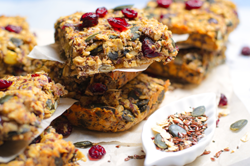In the previous newsletter, I shared information about Probiotics, specifically what strains are best to treat specific conditions. This month I’m diving into a topic that is less frequently discussed, but is just as important for gut health, prebiotics.
Prebiotics are essential for probiotics to work. In their simplest form they are fibers and natural sugars that foster the gut’s good bacteria. Think of prebiotics as food for probiotics. They work together to build and maintain healthy gut bacteria. And if we’ve learned anything from the science of nutrition, the foundation of a healthy mind and body is healthy gut bacteria.
Cheers!
|
|
|
Prebiotics 101: What, Why & How
|
 As long as I can remember, nutrition and wellness experts have been preaching the importance of eating a high fiber diet. The benefits includes everything from maintaining healthy bowel habits, to lowering cholesterol as well as controlling blood sugar levels and maintaining a healthy weight. Now with the discovery of the role prebiotics play in supporting a healthy gut, there is even more reason to consume fiber-rich foods. As long as I can remember, nutrition and wellness experts have been preaching the importance of eating a high fiber diet. The benefits includes everything from maintaining healthy bowel habits, to lowering cholesterol as well as controlling blood sugar levels and maintaining a healthy weight. Now with the discovery of the role prebiotics play in supporting a healthy gut, there is even more reason to consume fiber-rich foods.
What are Prebiotics?
Prebiotics are the indigestible components of some foods. For the most part, prebiotics are abundant and easy to source, due to the fact that they naturally occur in foods that are good for you. Therefore, there is no need for most people to take a prebiotic supplement.
The term prebiotics was termed by professor Glenn Gibson and Marc Roberfroid who also developed specific criteria that food must have to qualify as a prebiotic, which includes:
- Non-digestible by the upper gut
- Utilized by beneficial microflora in the colon
- Discriminate what microflora can be altered to a healthier composition
- Bring about beneficial effects
Why Are Prebiotics Important?
- Supports healthy gut bacteria, which in turn can enhance digestion and metabolism
- Promotes a healthier immune system by creating an environment that is difficult for disease-causing bacteria to survive
- Enhances mineral absorption, especially calcium and magnesium
- Lowers blood cholesterol
- Stabilizes blood sugar levels and insulin response
How to Increase Prebiotic Intake:
The first step is to simply start consuming more plant-based foods including vegetables, fruits, nuts, seeds, beans, legumes and whole grains. A few ideas to get you started include: start your day with a high-fiber breakfast cereal such as bran flakes or oatmeal, boost your mid-afternoon slump by snacking on fruit, nuts and seeds, and add beans and legumes to your favorite soups and salads for dinner.
Is There a Downside to Increasing Prebiotic Increase:
Technically no, but some may experience an increase in gas or flatulence. As you increase your fiber intake, you naturally will also increase your plant intake and with this comes an increase in gas production. To help counter this uncomfortable (but completely normal response), start by slowly increasing your fiber intake, allowing your gut to adjust.
Prebiotics may not be appropriate for those on a low-FODMAP diet which is why working with a registered dietitian to customize a plan for you is invaluable.
|
|
|
15 Food Rich in Prebiotics
|
 - Apples
- Bananas
- Onions
- Garlic
- Leeks
- Jerusalem Artichokes
- Asparagus
- Chicory Root
- Dandelion Greens
- Bran
- Barley
- Oats
- Chickpeas
- Lentils
- Kidney Beans
|
|
Featured Recipe
Cranberry Almond Flax Oat Bars
|
 Recipe by: Quaker Oats Recipe by: Quaker Oats - 2 Cups Quaker® Oats (quick or old fashioned, uncooked)
- 1/3 Cup ground flax seed
- 1/2 Teaspoon ground cinnamon
- 1/4 Teaspoon ground ginger
- 1/4 Cup unsweetened dried cranberries
- 1/4 Cup almond butter
- 1/2 Cup water
- 2 Tablespoons honey
- 1/4 Teaspoon almond extract
- 3 Tablespoons sliced almonds
Instructions
In large bowl, stir together oats, flax seed, cinnamon and ginger. Stir in cranberries. In a small bowl, stir together almond butter, water, honey and almond extract. Add oat mixture and stir to combine well. Let stand 5 minutes or until mixture holds together when pressed. Line an 8x4 inch loaf pan with foil, leaving some foil hanging over sides. Spray with nonstick cooking spray. Press oat mixture evenly into pan. Top with sliced almonds, pressing lightly. Cover with overhanging foil. Refrigerate until firm and set, about 2 hours. To serve, remove oat mixture from pan. Cut in half lengthwise, then crosswise into 12 pieces. Store, covered, at room temperature up to two days or refrigerate, covered, up to one week.
Makes 12 servings
Nutrition per serving: Calories 110, Total Fat 6g, Saturated Fat 1g, Cholesterol 0mg, Sodium 0mg, Carbohydrates 16g, Dietary Fiber 3g, Sugar 5g, Protein 4 g
|
|
|
Be Inspired
|
|
"Some things you have to do every day. Eating seven apples on Saturday night instead of one a day just isn’t going to get the job done."
- Jim Rohn
|
|
|
About SO Nutrition
|
 Stephanie Leipprandt Ouellette, MBA, RDN, LD
Stephanie Leipprandt Ouellette, MBA, RDN, LD Stephanie has been working in the field of nutrition and dietetics since 1995. She earned a Bachelor of Science degree in Dietetics from Michigan State University, completed an Approved Pre-Professional Practice Program at Western Michigan University and earned a Master of Business Administration from Baker College. She’s been a Registered Dietitian Nutritionist since 1996 and licensed in Texas since 2007. In 2008, Stephanie earned her certification in Childhood and Adolescent Weight Management. Stephanie has extensive clinical & managerial experience, both in corporate settings and in the community. Now she wants to share her knowledge with you, because most (if not all) nutritional habits begin at home.
Stephanie and her family reside in Katy, Texas
|
|
| |
Copyright © 2019 Customized Nutrition Newsletters, All rights reserved.
|
|
| |
|
|